Tomato Problems: What’s Wrong With My Tomato?
As an Amazon Associate and member of other affiliate programs, I earn from qualifying purchases.
The most frustrating part of tomato growing is dealing with tomato problems. It’s so irritating to wait all year for your homegrown tomatoes only to have them ruined by disease, pests, or rotten spots.
This article aims to help you identify and address issues that affect the tomato fruit. A companion article covers tomato leaf problems.
Tomatoes are one of the most popular food plants in home gardens. It’s often the first type of vegetable a person tries to grow at home. But often, home growers become frustrated if their tomatoes don’t ripen, have blemishes, or are ruined or stolen by pests.
Common Tomato Problems In The Home Garden
Sometimes there’s nothing that can be done about tomato problems, but sometimes you can prevent them from coming on with a little knowledge about what causes the problem.
Blossom End Rot – Brown or black rotten spots on the bottom
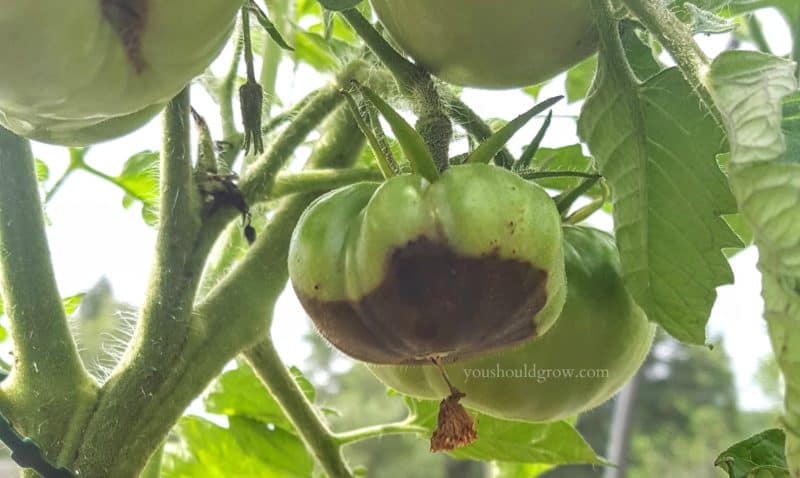
Blossom end rot is one of the most common problems with tomatoes. It is related to calcium uptake within the fruit. It is often recommended to add calcium to your soil at planting or after blossom end rot is noted.
However, we now know that a lack of calcium in the soil is usually not the problem. Read all about blossom end rot and the 2 biggest myths surrounding it. To prevent blossom end rot, plant resistant varieties, mulch around your plants, and don’t give them too much fertilizer.
Cracking Fruit – Split Open Fruit
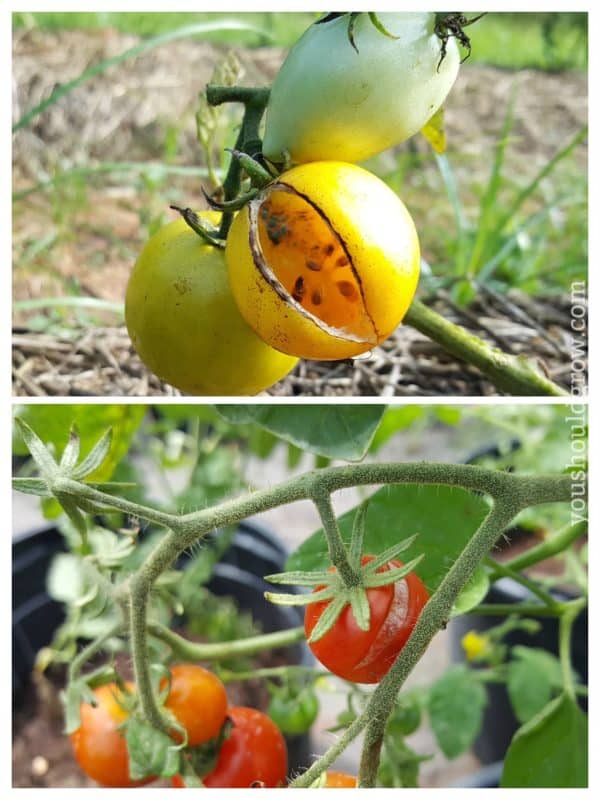
Another very common tomato problem is cracks in your fruit’s flesh. The cracks may form in circles around the stem or radiate outward from the stem. Radial cracks are very common, often heal on their own, and do not affect the health of the tomato. These types of cracks are more common on larger tomatoes and can be cut off with the stem. The remainder of the tomato is still good for eating.
Circular cracks are often found in cherry tomatoes. Sometimes the tomato will be busted open entirely. These types of cracks are more prone to growing mold than radial cracks.
Cracks are often the result of heavy rainfall or overwatering, but they also appear in periods of rapid growth. Some tomatoes are more prone to cracking than others, but it could happen to any tomato. To help prevent cracking, don’t over-prune your tomato, plant a variety that is less prone to the problem, and apply heavy mulch to help maintain consistent soil moisture.
If you find that most of your tomatoes on a particular plant are cracking, you can try picking them green and letting them ripen indoors. Also watch your weather, and pick your tomatoes before a heavy rain.
Can you use tomatoes that have split on the vine? If you see a tomato that has split, you should go ahead and pick it. Although it’s perfectly fine to eat a tomato that has cracked, if you see any black mold on the crack, it’s best to toss it into the compost.
Lumpy fruit with raised ring-shaped discolorations
These lesions on tomato are a symptom of Tomato Spotted Wilt Virus. TSWV is a viral infection transmitted by thrips that can be a problem not just for tomatoes but for many different species of plants. Infected plants are unsalvagable and should be destroyed. Make sure to treat your plants for thrips to prevent further infection.
Hard brown or gray scarring on the bottom (aka cat facing)
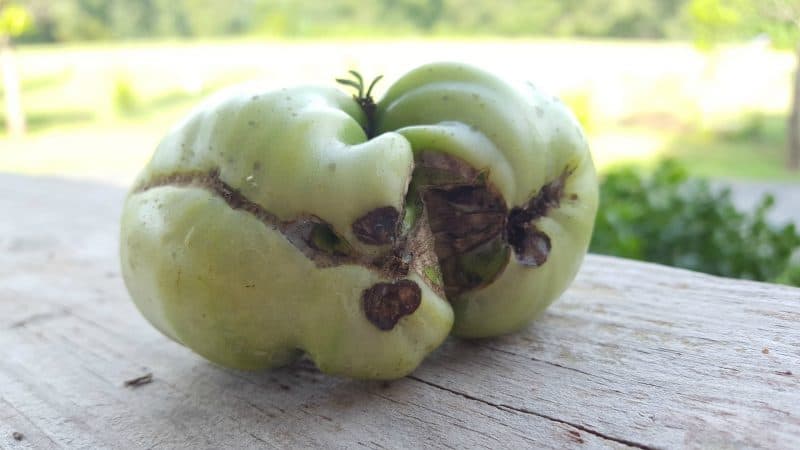
Most gardeners have dealt with one of these tomato problems. Cat facing is the term used for irregular shape and scarring of the blossom end of tomatoes. This is a physiological disorder that can cause significant damage to your fruit causing quite an ugly tomato.
While there is a genetic predisposition to cat facing, we know that it is usually seen in large tomatoes that develop from large blossoms. Damage to the flower, cool temps in the 60s F during flowering, and aggressive pruning can all contribute to cat facing. Heirloom beefsteak tomatoes seem to be prone to catfacing.
Can you eat scarred tomatoes? Although the scarred bottoms are not very attractive, these tomatoes can still be very tasty. Sometimes the wrinkles and scars can crack and develop rot or mold, but often the remainder of the tomato is fine for eating.
To prevent these tomato problems, choose varieties less prone to the problem, make sure to plant your tomatoes after temps have risen to over 60 degrees F, and don’t over prune your plants.
Zipper like scars on the skin
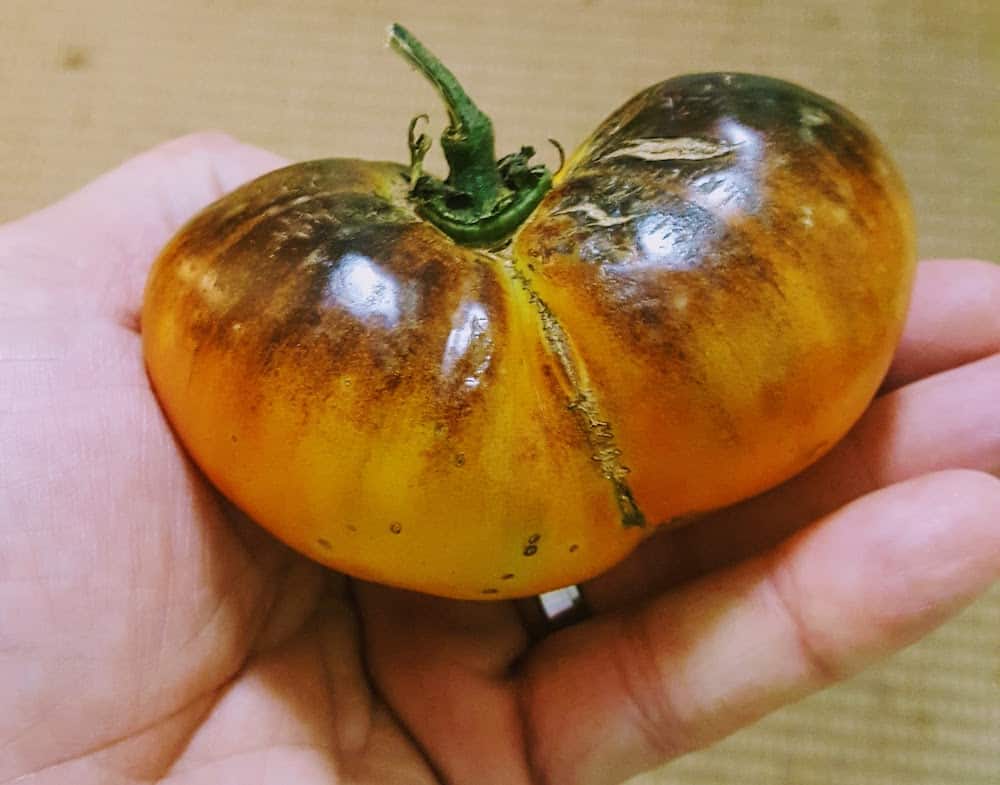
Similar to cat facing, zippering of tomatoes is a common cosmetic deformation of the surface. Zippering occurs when the flower’s anther becomes stuck to the inside of the fruit as it’s developing. As the fruit continues to grow, thin brown necrotic scars develop along the skin.
This one is easy to spot by its characteristic zipper-like lesions. You might even think your tomato looks like it has stitches. One to several longitudinal scars can form during fruit development. Scars can vary in length and depth with really bad scars causing holes in the fruit. In the worst case, you can even end up with deformed tomatoes.
Causes of tomato zippering include high humidity – which makes the anther sticky – and cool weather – which also affects tomato flower behavior. Additionally, certain tomato varieties and cultivars are more prone to zippering.
Can you eat a tomato with zippering? The good news is that you can still eat tomatoes with zippering – unless it’s caused cracking and molding. You’ll want to peel the skin off because the zippered skin is not going to taste very good.
Holes in the fruit
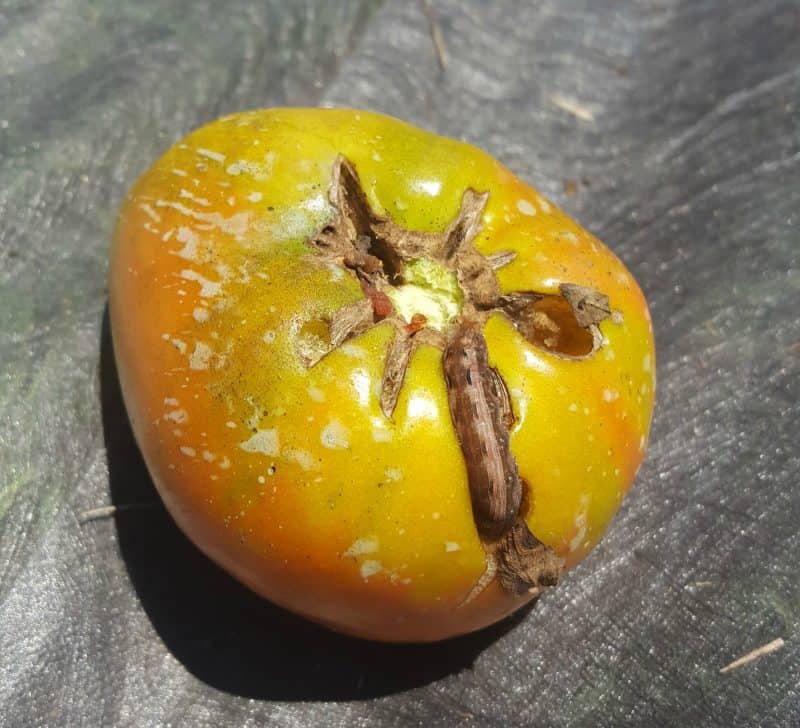
Possibly the most infuriating of all tomato problems is finding small holes in your tomatoes. Usually, upon investigation, you will find that the culprit for the damage is a worm, or technically, a caterpillar.
In the image above the caterpillar is kind of blending in with the cracks, and the gray spots are dried Bt…ironically.
Tomato fruit worms are black/brown worms that burrow into green tomatoes and take up residence, munching and living inside your precious tomato. Tomato hornworms will eat the fruit, but don’t burrow into it. Hornworms will also eat your tomato leaves all the way down to the stem.
Worm damage will often cause the tomato to ripen early or in an unusual pattern. It’s very common to pick a beautiful ripe tomato only to find worm damage on the underside which caused it to ripen before all the others.
What is additionally disturbing is that hornworm caterpillars also leave behind large turds on your tomato plant leaves and fruit. Ew! If you see little poos on your plant, go hunting for a caterpillar.
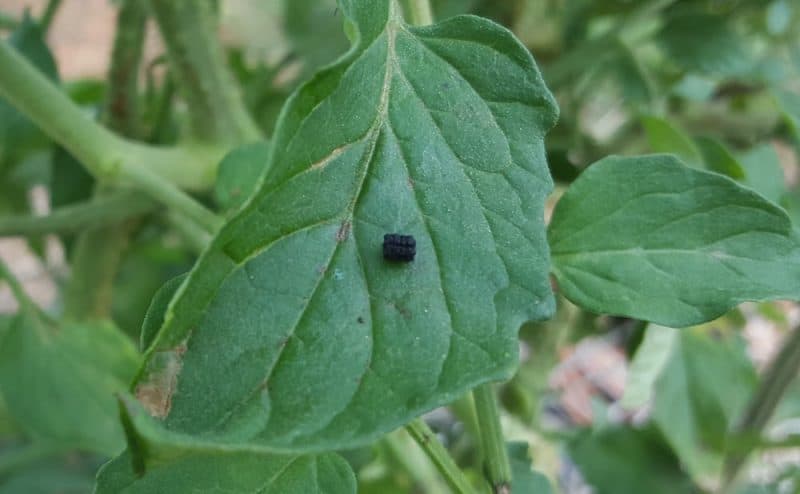
Look all along the stem, under leaves, and inside of fruit to remove and destroy these creatures. Additionally, an application Bt or spinosad insecticide will help kill off most of the beasts.
Read more: The Bugs In My Tomatoes
Birds, rodents, and rabbits may also take bites out of your ripening fruit. Physical barriers around and over your tomatoes will help prevent crop loss.
Portions of the tomato are pale to white
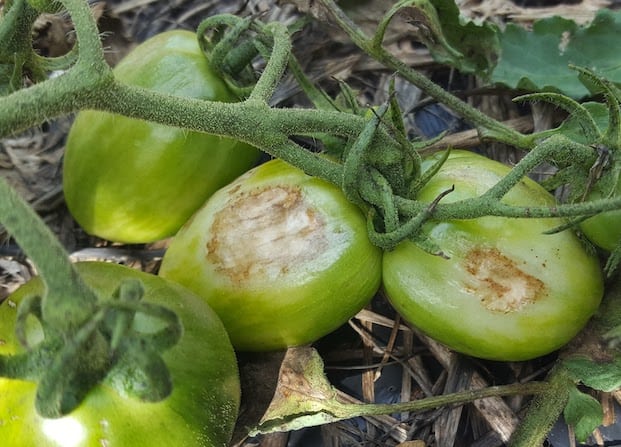
Tomatoes can suffer from sunburns, too. These pale white areas are called sunscald (image). The damage occurs from too much sunlight and will usually begin rotting very quickly. If you live in an area where the summer sun can be harsh and relentless, make sure that you provide some protection from its rays for your tomatoes.
Usually, just allowing the plant’s leaves to shade the fruit is fine but that can be affected by excessive pruning. If you do experience sunscald, just remove the affected portion. The fruit will not ripen evenly, but portions of it are sometimes still edible. To prevent sunscald, don’t over prune your plants or plant in an area where they receive some late afternoon shade.
Large brown rough spots that are firm to the touch
If you find spots like this on your tomato plants, I’m sorry to tell you that you have late blight. Late blight is a fungal infection of tomatoes that often shows up when nights are cool and days are warm.
Late blight also causes brown lesions on tomato leaves often with white fuzzy growth underneath and brown or black lesions on the stems of your plants.
This is one of those tomato problems that will ruin your entire garden. Make sure to carefully bag up and remove all portions of the plant from your garden. Sadly, there is no treatment for late blight once it infects your plants, and it quickly spreads from plant to plant.
If you’ve lost a crop to late blight, you might consider planting resistant varieties like Iron Lady and Matt’s Wild Cherry. Application of organic fungicides may help prevent the disease but will not save infected plants.
Brown craters on ripe fruits
Another frustrating fungal disease of tomatoes called Anthracnose (image) will cause sunken lesions on your fruit and dark water-soaked lesions on the leaves and stem of your plants.
When you see signs of this disease, remove and destroy infected plants. An organic fungicide may be of help for the remaining plants. Do not plant tomatoes in this area for the next 3 years.
Small white or black spots on fruit
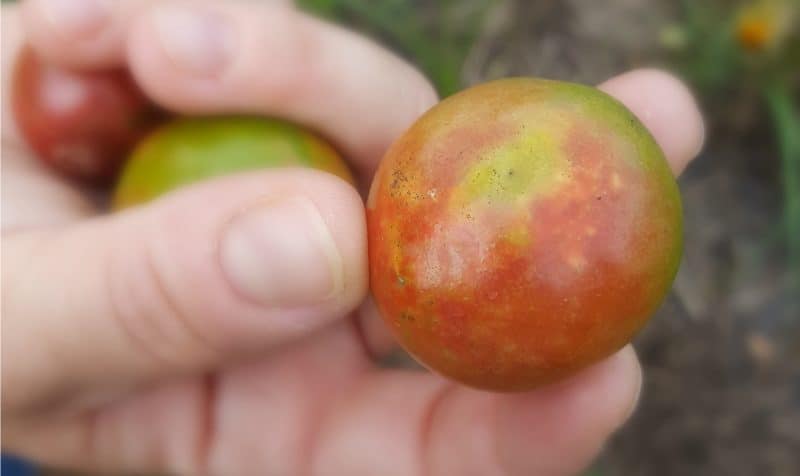
These tiny cloudy spots are caused by pests piercing the skin of the tomato for food. Very often these tomato problems are caused by the dreadful stink bug and leaf-footed bugs.
These horrible creatures are prolific if not kept under control. You can try diatomaceous earth to kill the nymphs of these pests, but the adults must be hand picked or, if you’re faced with losing most of your crop to these pests, apply organic pyrethrin pesticide.
Small brown specks on the shoulders
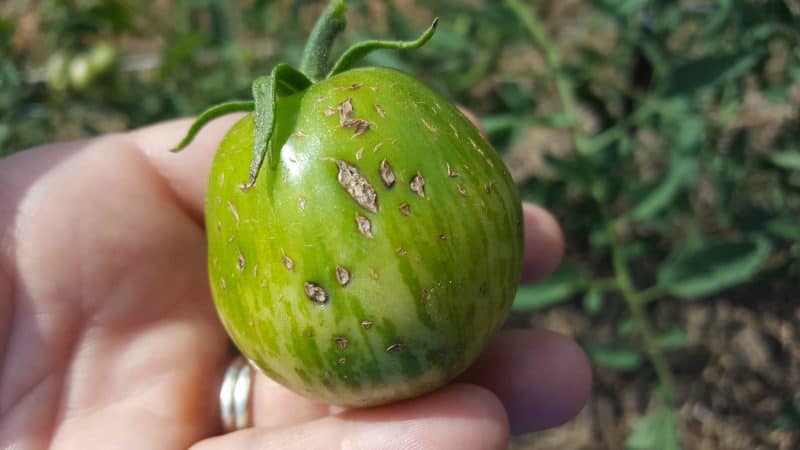
Rain check is a frustrating condition that can ruin the beauty of your tomatoes. The small specks are like tiny scars that may have a rough texture. It is caused by excessive moisture and usually appears on green fruit. We’ve had a big problem with rain check this year since the weather has been so rainy.
To help prevent this condition, don’t over prune your plants to allow some leaf coverage. Although this condition is unsightly, usually these fruits are still edible.
Uneven ripening or yellow shoulders
Yellow shoulder disorder can affect any tomato and appears as yellow areas on the top of the tomato (image) that never ripen. Inside, the yellow portion is hard and inedible. Uneven ripening is often a result of environmental conditions. If the weather has been too cool and rainy, you may find your tomatoes don’t ripen evenly.
Poor quality soil with low organic matter, low phosphorous, or increased pH can also affect ripening.
Fruit that does not ripen
Tomatoes can be fickle little beasts. If the weather is too hot (over 90F), their metabolism slows or halts, and they don’t make the pretty red pigment (lycopene) that signals ripening.
Keep in mind that not all varieties will turn red, so make sure you know what tomato you’re growing. If your red tomatoes are pale or washed out in color, consider picking them at first blush and bringing them indoors to finish ripening.
What if the plant doesn’t set fruit?
No tomatoes on your plant is certainly a problem! If you don’t have any baby tomatoes on your plant, take a close look at the flower clusters. You might notice that the flowers dropped off of the cluster at some point.
Dropping flowers most often occurs because of extreme high temperatures. When day temps are in the 90s and nighttime is over 70, the flowers can have pollination problems. You can also experience trouble with pollination if your plants are over or under fertilized and in very very dry or wet environments.
To ensure the best fruit production, make sure not to plant your tomatoes too late in the season. If you’re already having trouble with fruit set, let the suckers/side shoots grow to increase the number of flowers and odds of growing a tomato.
What other tomato problems have you experienced?
Share your experience in the comments below.
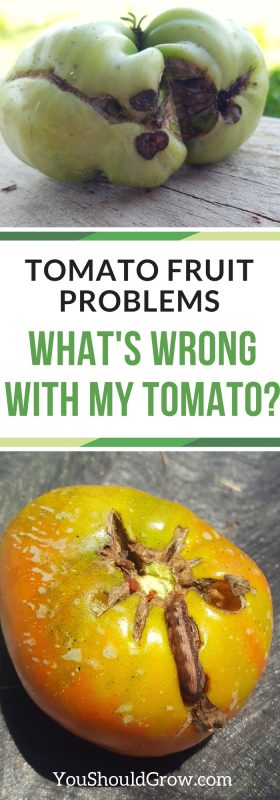


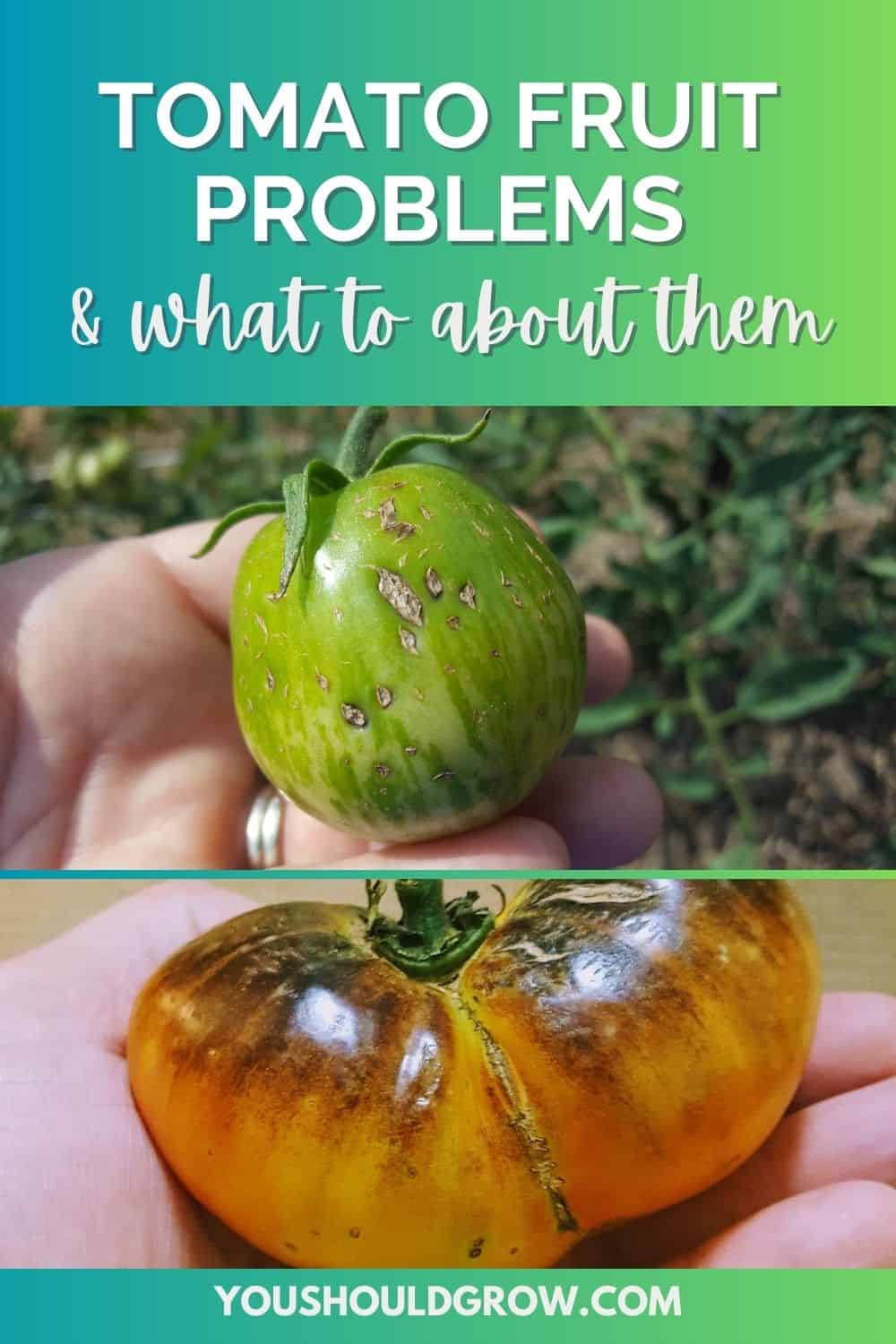
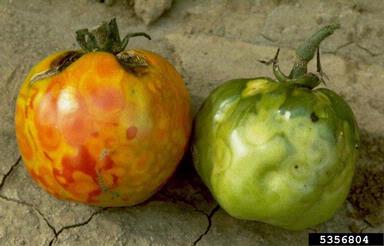
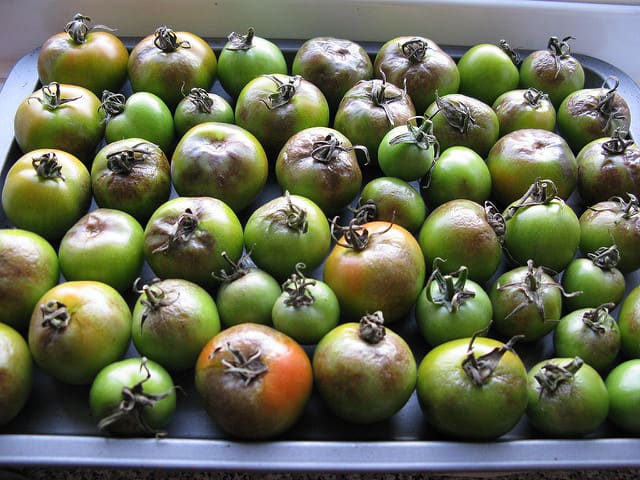
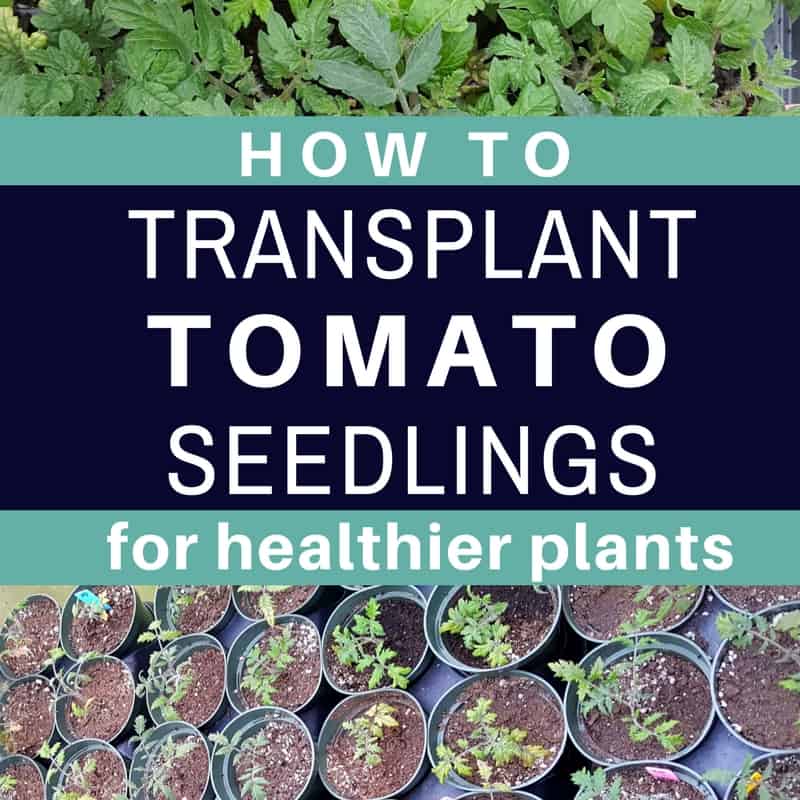
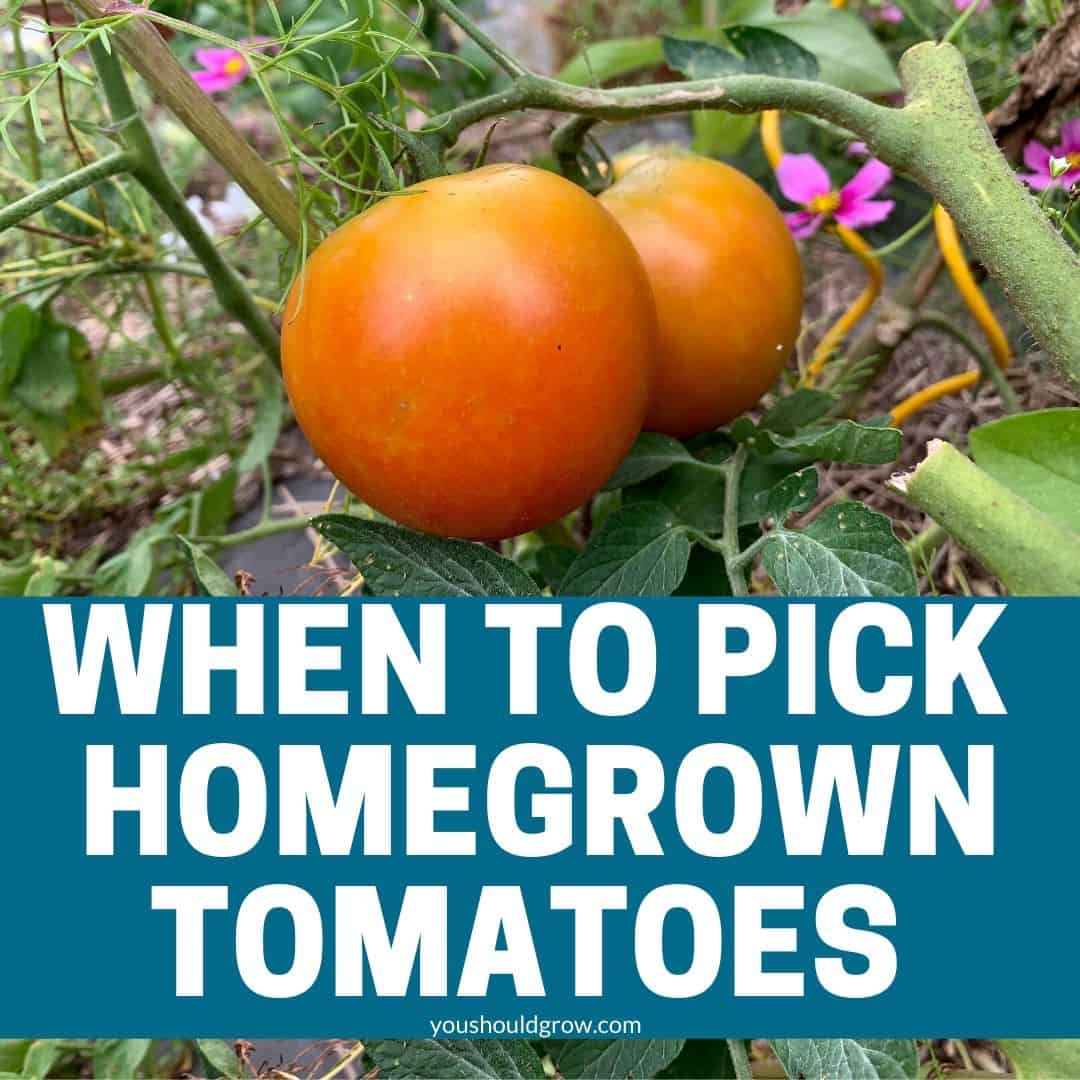
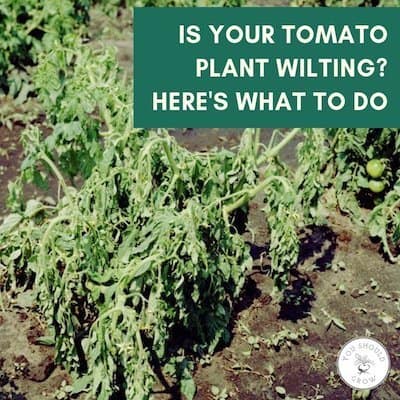
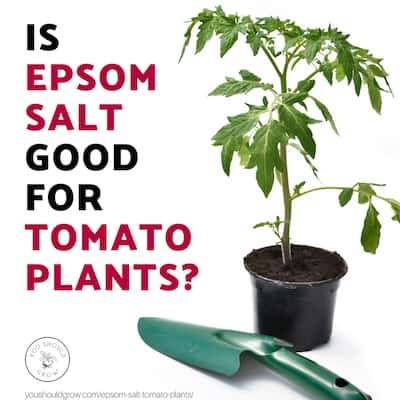
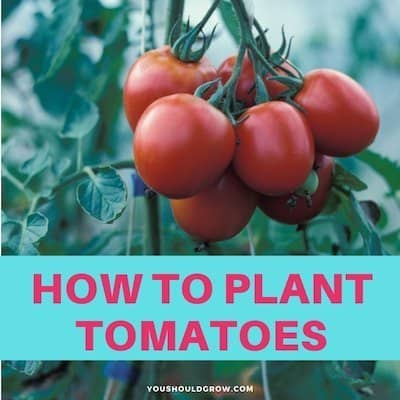
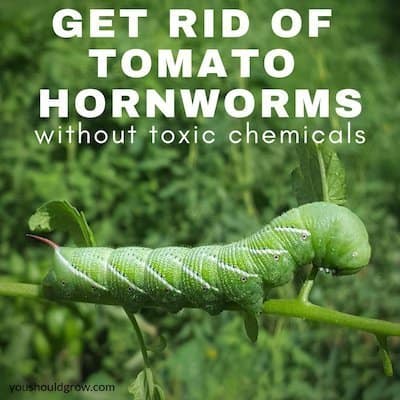
I just found your blog and I really enjoyed reading it. You can feel your energy for gardening! So fun!
Hey, Becky! Thanks for visiting! It’s nice to ‘meet’ you!
This is a great visual guide to tomato problems. A must read for all tomato growers. Nice article!
Thanks, Kathy!!
We put plants in buckets to hang to grow them upside down. I used a mixture of regular dirt and potting soil. We live in the southeastern part of Pa. Our plants are not producing many tomatoes and the ones it does do not rippen. Any ideas? Thanks
If your plants are otherwise healthy, then it could be that it’s too hot. Tomatoes won’t set fruit over about 85F.
Thanks. I finally read about the problem I have with my tomato plant. The ugly cat issue. Thank you for helping me with this issue. My other large tomato plant is doing awesome. Keep up the great work!
I’m very glad to hear it was helpful. Thank you!
My plants didn’t blossom the plant growth was very tall 6ft are taller plant very healthy what went wrong tanah
Hi Tanah, it’s really hard to say without more information. Stress, heat, lack of nutrients, and disease can all affect blooming and setting fruit. Even the variety of tomato can influence the number of blooms and fruit set.
This was a great article. I garden has been a disaster this year due to intense heat. Maybe next year.
We all have years like that. 🙂 Definitely give it a go next year!
Our plants looked fine a lot of fruit then suddenly the plants looked liked they were frozen, but lowest temps were in the 50s , tomoto started to turn black all of our plants, leaves dryer up
That’s terrible! Do you think it could be late blight?
hi, the issues have with my tomatoes first of all i cant seem to keep them tied up and my tomatoes are going bad cause they are on the ground, so i got all these tomatoes under the vines not even ripening. second, my leaves are looking dead, little holes on the leaves. plus i have rabbits eating them, what do i do? thank you
Sounds like they may need to be pruned. That will help you keep a closer eye on the tomatoes and leaves for pests and get some ventilation in and around the plants and pull them out of range of rabbits. Most tomatoes are indeterminates which means you can clip off any branches that are crowding or going in directions you don’t want. More branches will keep coming up as long as the plant is alive and well. Remember that some varieties of tomatoes can take 60+ days to ripen on the vine so make sure you’re giving them enough time. It seems like forever, I know! I’ve heard human hair and rubber snakes will keep rabbits out, too. Join me here and feel free to post pics and ask questions!
I had 6 tomato plants in huge pots. I had almost every problem you described above. Thanks for the information,
If you grow tomatoes, problems happen. But we keep doing it anyway because tomatoes are delicious. 🙂
We live in Puerto Rico and We planted tomatoes for the second time. My po roblem is i have a bunch of flowers but they arent turning into tomatoes. It doesnt get above 85 or below 70
Hi, Mary! That is frustrating! Are the flowers normal looking? Do they die and fall off? The other thing to consider is that high humidity can affect pollination. I wonder if that is the case.
Very informative. Thanks to you, I now know my tomatoes had anthracnose last year. You said not to plant in the same area for 3 years but it’s the only raised garden bed that I have. Is there something I can add to the soil to correct this problem so I can successfully have tomatoes this year?
Organic matter, probiotics, compost may help speed up getting rid of the disease. But if you can’t move them or grow in containers, then I would look for resistant varieties (resistance code A).
After a wetter than usual winter in Southern California I had 3 “surprise” tomato plants come up in my back yard. All are now quite large and are producing lots of tomatoes but the tomatoes on one plant look almost translucent compared to the tomatoes from the other two plants and are a bit watery. There’s no sign of any of the diseases discussed here. What would cause this? All 3 plants are growing side by side.
Sounds like you have different varieties that have come up. Usually, watery tomatoes are also a sign of over watering.
I grow Jetstar tomatoes, and this year, for the first time, I am finding that they have a very sticky coating on the skin that does not wash off. I peel them and they tasted great, but why are they sticky?
Did you see any bugs? A lot of pests excrete a sticky substance after sucking on tomato plants. Or could it have been something you sprayed-like a horticultural oil?
hello
I cut a bunch of tomatoes and they were all largely white-ish instead of the usual red/orange color. what might be the reason, you think?
So either they’re a white variety (which usually are a pale yellow to white color) or they have sunscald which is a sunburn on the tomato fruit. White tomatoes are edible, but sunscaled tomatoes are not.
Thanks for the informative site. I have gorgeous healthy looking plants but the first tomatoes to ripen have a sort of blackish discoloration st the stem end/,top. I don’t think it’s blight because I actually need to prune back the huge green plants. Thanks
This is the first year I have tried to plant tomatoes. I think I should have read your article first. It seems to be a very daunting enterprise. My huge tomato plant (in a pot) has lots of little green tomatoes, but I noticed some have black marks on the bottom. Should I take those off now? Is it too late to add calcium now, if that is indeed the problem. Where can I buy calcium? Your article is super informative and thank you for sharing your expertise.
What about tomatoes half ripening and half green? Smooth skin and beautiful plant.
The past few years no matter what variety of tomato we grow on our family farm they end up with hard places inside the fruit. It’s like the core, but extended out from it into the walls of the tomato. Any thoughts?